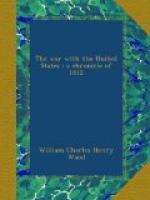The British Army. The British Army, like the Navy, had to maintain an exacting world-wide service, besides large contingents in the field, on resources which had been severely strained by twenty years of war. It was represented in Canada by only a little over four thousand effective men when the war began. Reinforcements at first came slowly and in small numbers. In 1813 some foreign corps in British pay, like the Watteville and the Meuron regiments, came out. But in 1814 more than sixteen thousand men, mostly Peninsular veterans, arrived. Altogether, including every man present in any part of Canada during the whole war, there were over twenty-five thousand British regulars. In addition to these there were the troops invading the United States at Washington and Baltimore, with the reinforcements that joined them for the attack on New Orleans—in all, nearly nine thousand men. The grand total within the theatre of war was therefore about thirty-four thousand.
The Canadian Regulars. The Canadian regulars were about four thousand strong. Another two thousand took the place of men who were lost to the service, making the total six thousand, from first to last. There were six corps raised for permanent service: the Royal Newfoundland Regiment, the New Brunswick Regiment, the Canadian Fencibles, the Royal Veterans, the Canadian Voltigeurs, and the Glengarry Light Infantry. The Glengarries were mostly Highland Roman Catholics who had settled Glengarry county on the Ottawa, where Ontario marches with Quebec. The Voltigeurs were French Canadians under a French-Canadian officer in the Imperial Army. In the other corps there were many United Empire Loyalists from the different provinces, including a good stiffening of old soldiers and their sons.
The Canadian Embodied Militia. The Canadian militia by law comprised every able-bodied man except the few specially exempt, like the clergy and the judges. A hundred thousand adult males were liable for service. Various causes, however, combined to prevent half of these from getting under arms. Those who actually did duty were divided into ‘Embodied’ and ‘Sedentary’ corps. The embodied militia consisted of picked men, drafted for special service; and they often approximated so closely to the regulars in discipline and training that they may be classed, at the very least, as semi-regulars. Counting all those who passed into the special reserve during the war, as well as those who went to fill up the ranks after losses, there were nearly ten thousand of these highly trained, semi-regular militiamen engaged in the war.
The Canadian Sedentary Militia. The ‘Sedentaries’ comprised the rest of the militia. The number under arms fluctuated greatly; so did the length of time on duty. There were never ten thousand employed at any one time all over the country. As a rule, the ‘Sedentaries’ did duty at the base, thus releasing the better trained men for service at the front. Many had the blood of soldiers in their veins; and nearly all had the priceless advantage of being kept in constant touch with regulars. A passionate devotion to the cause also helped them to acquire, sooner than most other men, both military knowledge and that true spirit of discipline which, after all, is nothing but self-sacrifice in its finest patriotic form.




